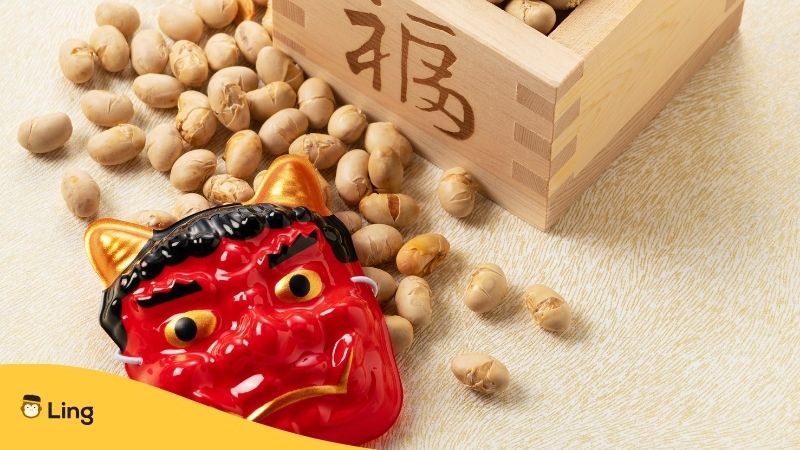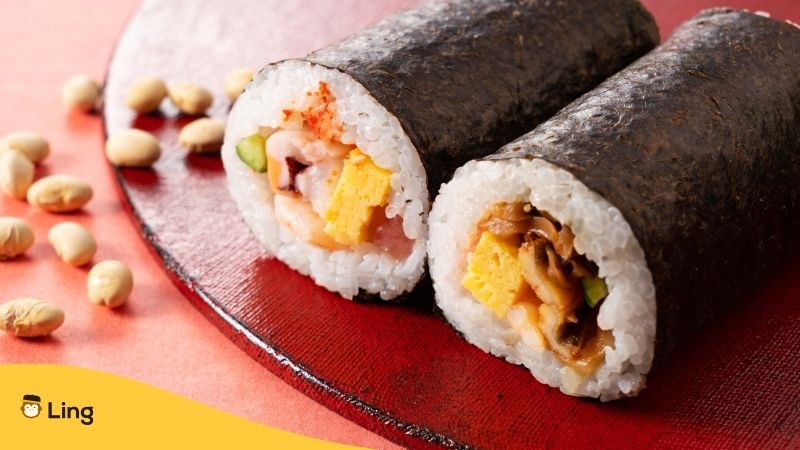Whenever I mention the Japanese Setsubun (節分) and its wacky soybean-throwing rituals to travelers headed to Japan in early February, I’m always met with bemused smiles and questions about what exactly this little-known holiday is all about. But lemme give you the primer: marking the beginning of spring each year, Japanese Setsubun celebrations drive out lingering evil spirits and welcome fresh starts, renewed luck, and good fortune for the year ahead.
In this beginner’s guide to one of Japan’s overlooked festivities, I’ll walk you through everything you need to know about the setsubun events and the best Japanese phrases for travelers. Ready? Let’s begin!
Table of Contents
@addyroad A day that combines it all 👹🍣 #lifeabroad #japanlife #japan
♬ original sound – Adele Collette
What Is The Japanese Setsubun?
If you’ve ever wanted to shout at invisible demons while wildly flinging soybeans across a room, then get yourself to Japan’s action-packed Setsubun festival. Setsubun marks the beginning of spring each year, falling on February 2nd, 3rd, or 4th, depending on the lunar calendar.
While Setsubun might sound a bit wacky to newcomers, this lively little holiday has been going strong for centuries. Its name translates to “seasonal division,” referencing the symbolic separation between winter’s darkness and spring’s fresh starts. Originally, Japanese people would spend this transitional period performing rituals to banish lingering evil spirits and purification ceremonies to welcome renewed fortune into their homes in preparation for spring.
Around the 13th century, popular rituals started taking shape – people would burn pungent sardine heads, crash drums loudly, and decorate entries with fish heads and sacred leaves to scare evil spirits away. While you likely won’t see many ornamental fish heads displayed these days, Setsubun customs have endured the test of time.
Nowadays, the two most beloved Setsubun traditions are the flinging of roasted soybeans called mamemaki (豆撒き) and eating lucky direction sushi roll or eho-maki (恵方巻き) During mamemaki, roasted beans are thrown wildly indoors and at temples while chanting “Oni wa soto! Fuku wa uchi!” (鬼は外!福は内!) or “Out with demons! In with happiness!”

What Is Mamemaki (豆撒き)?
Once those demons start knocking on doors as they roam the streets each Setsubun, it’s time to grab your soybeans and start flinging! The lively ritual of tossing roasted beans is called mamemaki, and it’s the headlining event of the Setsubun holiday. Mame literally translates to bean, so mamemaki signifies the scattering of beans to banish demons and welcome in happiness and good luck for the new year. Legend promises that catching and eating the amount of beans matching your age will bring an exceptionally lucky year too!
According to the locals, Japanese families usually assign the male whose Chinese zodiac animal matches that year’s zodiac to be the major bean-throwing commander. In some households, fathers will even dress up as red-faced demons and gleefully play the role while kids throw beans at them to ritualistically drive the monster and past year’s misfortunes away.
Why Are Soybeans Used For Setsubun?
Within the spiritual Shinto tradition, soybeans are revered as the second most auspicious food after rice. Their significance stems from being nutritionally dense, their long storage life, and soy’s role as an essential dietary staple. Much like rice, soybeans represent bounty, health, and life’s provisions.
Beyond being a lucky symbolic food though, soybeans have another advantage – they’re also bigger and heartier than delicate grains of rice. When evil spirits start lurking around homes each Setsubun, Japanese families need an ingredient that packs some demon-fighting punch! Soybeans became the choice missile for literally casting misfortune out the door.

What Is Ehomaki (恵方巻)?
Once you’ve finished flinging soybeans during the lively mamemaki ritual, it’s time to sit down and feast on some fortunate sushi for Setsubun – ehomaki! These thick, uncut sushi rolls bursting with symbolic ingredients are another favorite food tradition believed to usher in luck and prosperity for the coming year.
Ehomaki simply translates to “lucky direction roll,” as they are always eaten while facing the year’s appointed fortunate direction. The direction shifts annually and is decided by geomancy experts according to the lunar calendar. Tradition holds that silently consuming the entire ehomaki roll in one direction solidifies blessings for the next 12 months!
In addition to lucky direction dining, the ingredients tucked within ehomaki hold significance too. Classic recipes call for seven fillings to represent the Seven Deities of Good Fortune, known in Japan as Shichifukujin. While the ingredients vary by region and taste, it’s the lucky number seven that matters most when stuffing an emaki full of fresh fish, egg creations, vegetables, and more.
@hellotalk.japanese Do you know Setsubun (節分)? @kaai_san #setsubun #culture #learningjapanese #hellotalk
♬ オリジナル楽曲 – HelloTalk_Japanese – HelloTalk_Japanese
Easy Japanese Words For Setsubun
Want to celebrate Setsubun like a true local? Mastering a few keywords and phrases will level up your soybean-throwing skills and have you dining on fortune-filled sushi in no time!
Here are 5 must-know Setsubun terms to get your vocabulary started!
Oni (鬼) – Demon
Setsubun marks the time when invisible oni or folklore demons arrive to wreak havoc. Better pelt them with soybeans quickly!
Mamemaki (豆撒き)- Throwing Beans
As you scoop up handfuls of beans to wildly toss across the room, you’re officially doing “mamemaki”!
Fuku (福)- Fortune/Good Luck
Make sure to wish your family and friends “fuku” or blessings of good luck when the new spring season arrives after Setsubun.
Ehomaki (恵方巻)- Lucky Direction Roll
This special thick sushi roll stuffed with 7 symbolic ingredients will have your incoming year brimming with “eho” or good fortune!
Oni wa soto! Fuku wa uchi! (鬼は外!福は内!) – Demons out, Fortune in!
Chant this signature phrase and the Setsubun mantra as you drive those demons away and beckon in fortune one soybean at a time.
Ready To Join The Traditional Bean Throwing Event?
Now that you know about Setsubun customs like mamemaki and understand lucky language vocabulary too, you can embrace the holiday’s playful purification spirit anywhere Japan’s culture takes you next. And if you’d like to keep expanding your Japanese language skills beyond my Setsubun starter words, I highly recommend apps like Ling.
Ling helps demystify one of the world’s most intricate languages through fun, flexible lessons and study tools. It’s a great next step to unlock even more of Japan’s cultural beauty as you travel or live abroad! However you choose to connect with Japan’s festivities and fascinating lexicon, I’m wishing everyone an eho-filled year ahead after an auspicious Setsubun celebration. Fuku wa uchi – good fortune dwells within us all!


































































